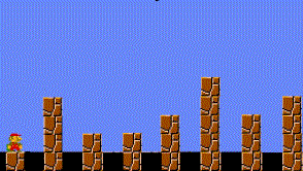Programming contestsMagas szintű programozási nyelvek 1, egyéni verseny, 2016. április 10.
April 10, 2016, 10:00 AM –
April 10, 2016, 3:00 PM
|
Jumping Mario

Mario is in the final castle. He now needs to jump over a few walls and then enter Koopa's Chamber, where he has to defeat the monster in order to save the princess. For this problem, we are only concerned with the “jumping over the wall” part. You will be given the heights of N walls from left to right. Mario is currently standing on the first wall. He has to jump to the adjacent walls one after the other until he reaches the last one. That means he will make N – 1 jumps. A high jump is one where Mario has to jump to a taller wall, and similarly, a low jump is one where Mario has to jump to a shorter wall. Can you determine the number of high jumps and low jumps Mario has to make?
Input Specification
The first line of the input is an integer T (T < 30) that indicates the number of test cases. Each test case starts with an integer N (0 < N < 50), indicating the number of walls. The next line gives the heights of the N walls from left to right. Each height is a positive integer not exceeding 10.
Output Specification
For each test case, output the case number followed by 2 integers, the number of high jumps and the number of low jumps, respectively. Look at the sample output for exact format.
Sample Input
381 4 2 2 3 5 3 41951 2 3 4 5
Output for Sample Input
Case 1: 4 2Case 2: 0 0Case 3: 4 0